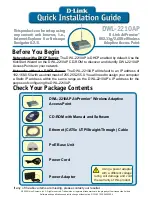
Network configuration
Discovery protocols
5-13
Mandatory TLVs
The AP always sends these TLVs with the values as shown.
Chassis ID
(Type 1): The MAC address of the AP.
Port ID
(Type 2): The MAC address of the port on which the TLV will be transmitted.
Time to live
(Type 3): Defines the length of time that neighbors will consider LLDP
information sent by this agent to be valid. Calculated by multiplying
Transmit interval
by the
Multiplier
(as defined on the
Discovery protocols
page).
Optional TLVs
Select the optional TLVs that you want to send with the values as shown.
Port description
(Type 4): A description of the port.
System name
(Type 5): Administrative name assigned to the device from which the TLV
was transmitted. By default this is the SNMP system name. If the
Dynamic system name
option is enabled, the system name is replaced by the dynamically generated name. The
controller can only have one system name. If both the LAN and Internet ports have active
agents, then the name generated by the LAN port is used.
System description
(Type 6): Description of the system, comprised of the following
information: operational mode, hardware type, hardware revision, and firmware version.
System capabilities
(Type 7): Indicates the primary function of the device. Set to:
WLAN access point
for APs
Router
for controllers.
Management IP address
(Type 8): Specify the IP address on which the agent will
respond to management requests.
802.3 TLVs
The IEEE 802.3 organizationally specific TLV set is optional for all LLDP implementations.
The AP supports a single optional TLV from the 802.3 definition.
MAC/PHY configuration/status
This TLV provides the following information:
Bit-rate and duplex capability
Current duplex and bit-rating
Whether these settings were the result of auto-negotiation during link initiation or
manual override.
Summary of Contents for E-MSM310
Page 2: ......
Page 3: ...HP MSM3xx MSM4xx Access Points Management and Configuration Guide ...
Page 14: ...Contents xii ...
Page 26: ...Introduction Online documentation 1 12 ...
Page 51: ...Wireless configuration Radio configuration 3 9 E MSM460 and E MSM430 ...
Page 52: ...Wireless configuration Radio configuration 3 10 MSM422 ...
Page 53: ...Wireless configuration Radio configuration 3 11 MSM410 ...
Page 54: ...Wireless configuration Radio configuration 3 12 MSM335 radio 1 and 2 ...
Page 55: ...Wireless configuration Radio configuration 3 13 MSM335 radio 3 ...
Page 56: ...Wireless configuration Radio configuration 3 14 MSM320 ...
Page 57: ...Wireless configuration Radio configuration 3 15 MSM310 ...
Page 112: ...Working with VSCs Quality of service QoS 4 28 ...
Page 134: ...Network configuration 802 1X supplicant 5 22 ...
Page 196: ...Regulatory information B 16 ...
Page 208: ...Resetting to factory defaults Factory defaulting ruggedized products D 6 ...
Page 209: ......
















































